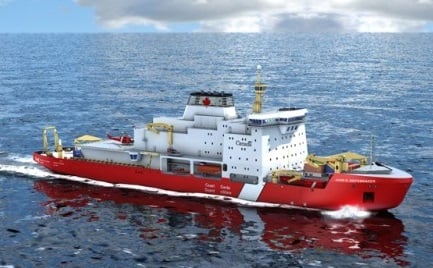Are Canada's Coast Guard Icebreakers Ready?
As the ice is receding in the Arctic, human activity has been on the rise. Will Canada’s Coast Guard icebreakers be there when we need them? Pierre Leblanc, a retired colonel and a former commander of the Canadian Forces in the Arctic, would like to see more icebreakers in operation:
The temperature at the North Pole on December 22, 2016, was 32F (0C), up some 36F (20C). Nature is baffling scientists by what seems to be an accelerating warming of the Arctic and the predictable impact on sea ice. That and the summer 2016 voyage through the Northwest Passage of the Crystal Serenity with more than 1,600 souls on board, and the Chinese plans to use the Northwest Passage should cause us to have a closer look at our fleet of icebreakers to see if we are prepared to deal with the massive changes taking place in the Arctic and our international commitments.
When I was the commander of the Joint Task Force North, my Canadian Coast Guard colleagues used to jest about the need for more icebreakers by saying, “Less ice means more icebreakers, more ice also means more icebreakers.”
On the surface, it is counterintuitive until you realize that when there is less ice, that ice will move around unpredictably and will strand vessels that will then need an icebreaker to free them. As the ice disappears, Arctic maritime traffic will continue to increase and the possibility of vessels becoming icebound will also increase.
 What alarms me at the moment is that our fleet of the seven icebreakers that are deployed in the Arctic has either passed or is approaching its end of service, with only one known planned new Arctic-capable icebreaker, the CCG Diefenbaker, to be built by Seaspan Marine Corporation as part of the National Shipbuilding Procurement Strategy. It is planned to be in service by 2025.
What alarms me at the moment is that our fleet of the seven icebreakers that are deployed in the Arctic has either passed or is approaching its end of service, with only one known planned new Arctic-capable icebreaker, the CCG Diefenbaker, to be built by Seaspan Marine Corporation as part of the National Shipbuilding Procurement Strategy. It is planned to be in service by 2025.
Compare this with the Russians who have more icebreakers than the rest of the world combined, including nuclear-powered icebreakers. The Russian navy has its own icebreaker. Even the Americans are now realizing that their part of the Arctic is seeing increased maritime traffic and that they are ill prepared with only one operational icebreaker.
The IMO has developed the Polar Code for vessels operating in the polar regions which took effect January 1, 2017. This code is welcomed in that it establishes minimum requirements for vessels operating in our Canadian Arctic. Although the Polar Code could have more stringent requirements, it is a significant first step in the right direction. The question is: who will monitor such standards and enforce the Polar Code in the Canadian Arctic?
On several occasions I saw our Canadian Coast Guard vessels in their vivid red and white colors displaying our maple leaf. In addition to our Inuit communities in the Arctic, they represent our best physical presence during the shipping season. In the not too distant future they will be accompanied by Canadian Forces Arctic Offshore Patrol Vessels, although the latter will not have a medium icebreaking capability.
One of the main functions of the Canadian Coast Guard has been to support the resupply of our northern communities. It has been said often that sovereignty presence starts with healthy Arctic communities. Their resupply is therefore an essential service.
Part of the reason for our lack of accuracy in predicting climate change in the Arctic is the limited amount of research that has been conducted there. The coast guard vessels have been an integral part of the scientific research conducted in the Arctic. That includes the research required to support our claims for extended continental shelves under the United Nations Convention on the Law of the Sea’s Commission on the Limits of the Continental Shelf.
The Canadian Coast Guard icebreakers would also be instrumental in monitoring commercial fishing in the Arctic and the Arctic fishing moratorium that the Arctic Five (Russia, U.S., Canada, Denmark and Norway) wish to enforce until such time as there is sufficient science to understand what is sustainable.
Canada is also a signatory of the Arctic Council Agreement on Cooperation on Aeronautical and Maritime Search and Rescue in the Arctic. Our Canadian Coast Guard vessels and their helicopters are key search and rescue assets in the Arctic. If our fleet is not replaced, how would we meet this international agreement?
Canada is also a signatory of the Arctic Council 2011 Agreement on Cooperation on Marine Oil Pollution and Response in the Arctic. Without a sizeable icebreaker fleet, how would we meet our obligations to monitor and respond to an incident?
As the ice is receding in the Arctic, human activity has been on the rise. Will our coast guard icebreakers be there when we need them?
This article originally appeared in The Hill Times and is reproduced with permission.
The opinions expressed herein are the author's and not necessarily those of The Maritime Executive.
